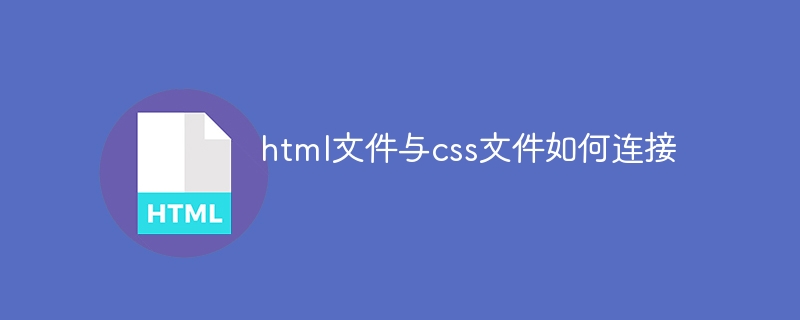Home >Web Front-end >HTML Tutorial >How to connect html files and css files
The connection of HTML and CSS files is crucial to the appearance and user experience of a web page. This article details the connection methods between HTML files and CSS files, including inline styles, internal style sheets, and external style sheets. By understanding these methods and related considerations, developers can effectively implement the style and layout of web pages.

The connection between HTML files and CSS files is an important link in front-end development, which is related to the appearance and user experience of the web page. The following will introduce in detail how to connect HTML files and CSS files, including the connection method, steps and precautions to help readers better understand and apply this technology.
1. Overview of HTML and CSS
HTML (HyperText Markup Language) is the basic structure of web pages. It defines the content, layout, tags and links in web pages, etc. , can be understood as the skeleton of the house. CSS (Cascading Style Sheets) is a style sheet, which controls the appearance, layout and color of a web page, and can be understood as the decoration of a house. Therefore, the combination of HTML and CSS is the key to achieving the beauty and functionality of web pages.
2. How to connect HTML files and CSS files
1. Inline Styles
Linked styles add CSS styles directly to the tags of HTML elements and define them through the style attribute. This method is suitable for style setting of a single element, but it is not conducive to style reuse and maintenance. For example:
<div style="background-color: red; color: white;">这是一个红色背景的div元素</div>
2. Internal Stylesheets
Internal style sheets write CSS styles inside the 93f0f5c25f18dab9d176bd4f6de5d30e tag of the HTML document, through c9ccee2e6ea535a969eb3f532ad9fe89 tag to define. This method is suitable for style setting of a single HTML document, and styles can be reused in the same HTML document. For example:
<!DOCTYPE html>
<html>
<head>
<style>
div {
background-color: red;
color: white;
}
</style>
</head>
<body>
<div>这是一个红色背景的div元素</div>
</body>
</html>3. External Stylesheets
External style sheets write CSS styles in a separate .css file and pass them through the HTML document The 2cdf5bf648cf2f33323966d7f58a7f3f tag is introduced. This method is suitable for multiple HTML documents sharing the same style, improving the reusability and maintainability of the style. For example, suppose we have an external style sheet file named styles.css with the following content:
div {
background-color: red;
color: white;
}Then introduce this style sheet into the HTML document:
<!DOCTYPE html> <html> <head> <link rel="stylesheet" type="text/css" href="styles.css"> </head> <body> <div>这是一个红色背景的div元素</div> </body> </html>
where, 2cdf5bf648cf2f33323966d7f58a7f3f The rel attribute of the tag specifies the relationship between the current document and the linked document. If it is set to stylesheet here, it means that the linked document is a style sheet file; the type attribute specifies the MIME type of the linked document. If it is set to text/css, it means it is. A CSS style sheet file; the href attribute specifies the path of the linked document, which can be a relative path or an absolute path.
3. Connection precautions
1. Path problem: When introducing an external style sheet, you need to ensure the correctness of the path. If the path is wrong, the browser will not be able to find and load the style sheet file, causing the web page style to become invalid.
2. Loading order: In HTML documents, the 2cdf5bf648cf2f33323966d7f58a7f3f tag is usually placed at the top of the 93f0f5c25f18dab9d176bd4f6de5d30e tag to ensure that CSS styles are available when the page is loaded. If placed later, it may cause page styles to flicker or become disordered during loading.
3. Style conflicts: When multiple style sheets or style rules act on the same element, style conflicts may occur. At this time, conflicts need to be resolved according to CSS priority rules (such as inline styles having the highest priority, followed by ID selectors, then class selectors and tag selectors).
4. Caching problem: The browser will cache loaded resources to improve loading speed. But sometimes caching will cause style updates to not take effect. At this point, you can try clearing the browser cache or changing the name of the style sheet file to force the browser to reload the style sheet.
4. Summary
The connection between HTML files and CSS files is one of the basic skills in front-end development. By mastering the three connection methods of inline styles, internal style sheets, and external style sheets and related precautions, we can better realize the beauty and functionality of web pages. In actual development, the appropriate connection method should be selected based on the needs and characteristics of the project, and best practices should be followed to optimize the loading and performance of the style sheet.
The above is the detailed content of How to connect html files and css files. For more information, please follow other related articles on the PHP Chinese website!